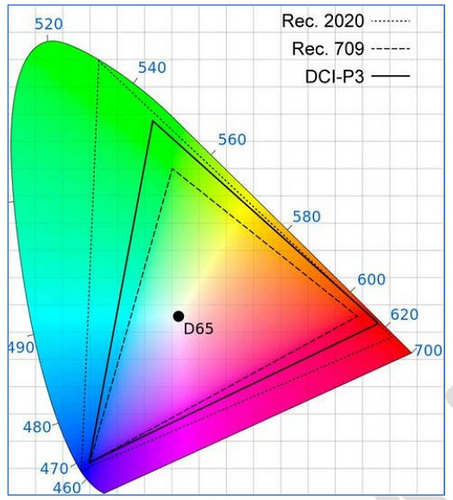Of all the technologies that have come out in the past decade, High Dynamic Range (HDR or HDR10) with the Wide Color Gamut (WCG) has made the biggest difference, more so than the 4K resolution, it just so happened that HDR and 4K standards came about at the same time and to save money, the manufacturers just bundled both together, although one has to do with the
Standard Dynamic Range (on the left) is 8 bit color, or 16,777,216 colors. They come up with that number using Red/Blue/Green (RGB) the three primary colors of light, and 8 bit is 256 shades of each color (256R x 256G x 256B) .
High Dynamic Range (on the right), is 10 bit, or 1,073,741,824 colors, which is 1024 shades of each color. This creates more detail, less banding, greater contrast between white and black and richer, more lifelike color. If you are looking for your next HDTV, projector, UHD Blu-Ray Player and AV Receiver, HDR should be on your list of must haves, as not everything UHD offer HDR (especially lower cost equipment). In fact, according to the big 5 TV manufacturers (LG, Sony, Samsung, Panasonic, and Visio) after 2019, there will only be 4K resolution TV sets. The differing factor will be HDR (whether it has it or not and what type).
In the chart, Rec. 709 is the 8-bit HD standard for 720p/1080p (44% of the visible eye spectrum). Rec.2020 is the ultimate level that the HDR compliance level can get to which is 78% of the visible spectrum. TV’s and projectors manufacturers put in for the DCI-P3 standard which is 58% of the visible spectrum. The problem, and this is both projectors and TV, is the level of light output to reach Rec. 2020 would have to be 20 times brighter with a better color depth than OLED, the current standard for contrast (infinite) and 12 bit color spectrum. The amount of light generated by the device is supposed to be 10,000 nits, the average today is between 800-1000, although Samsung again, showed off a 10,000 nit TV (they had sun glasses to watch the TV)
Frankly, staring into the sun would be more pleasant.

HDR is actually metadata that is encoded with a movie (4K movies are the only ones that do that) that tells the display device exactly what shade each of the 1 billion colors are supposed to be, using a very large color lookup table, for the entire movie, once at the beginning. There are three other HDR application, Dolby Vision, HDR10+, and Advanced HDR by Technicolor, along with HLG which is for live broadcast TV that take it a step farther and create Dynamic HDR vs Static HDR, adjusting for every scene or in some cases, each image in each scene.
All HDR capable devices can default to HDR10 so you will always get better image than SDR, and gaming consoles (PS4 Pro/X Box S/X with Enhanced Gaming Mode) and streaming services (Netflix, Vudu, Apple TV, Amazon Video) offer 4K/HDR content for viewing.
Unlike the VHS vs Betamax or HD DVD vs BluRay, the different versions of HDR are only different ways to view your content better. HDR10 is considered static HDR because it tells the display once how the entire movie is supposed to look. The other versions build on that (which is why it is the baseline) to add dynamic control over entire scenes or even individual images in a movie.
*HDR10+: A Samsung innovation
This adds dynamic HDR like Dolby Vision, but manufacturers don’t have to pay royalties to Dolby, or have a specialized chip. Problem is, it is Samsung’s implementation, and the leaders, LG and Sony won’t support a competitors format. Panasonic does in one of their UHD players, and recently Universal Studios stated that they will encode their 4K movies in HDR10+.
*Dolby Vision: Dolby Laboratories coupling sight and sound
Along with object based Dolby Atmos audio, Dolby Vision (DV) wishes to create a standard for theater/home similar to THX and IMAX . There is a royalty fee associated with using DV, and a specialized chip to process the dynamic metadata, but that may have changed with more powerful processing in TV’s to a software issue. Even though everything is encoded in HDR, DV is the highest adapted coding for higher end HDTV’s, 4K movies and TV, and streaming (Netflix, Vudu, AppleTV) but again, royalties to Dolby (similar to the ones to Sony for every BluRay/UHD player) along with the effort and expense to have the movie encoded with Dolby Vision, slow down it’s adaptation. Samsung UHDTV’s don’t support DV (because they have HDR10+), but LG, Panasonic, Visio, and Sony’s have models with DV, especially the OLED TV’s.
*Advanced HDR by Technicolor
Again adding dynamic content, but aimed at the streaming and broadcast markets to bring HDR to regular TV, along with SDR to HDR conversion, but they are the newest ones on the block, but already, since 2017, LG supports this format, even though there is nothing encoded in it but a couple of demos, it is more future proofing.
*Projectors
What has been left out of the conversation is projectors and there are a couple of reasons for this.
Because of the processing power (and royalties to Dolby) required, at this point no projector has Dolby Vision. In fact, HDR in projectors is not quite as effective because unlike OLED with infinite contrast and LED with local dimming, projectors don’t have the ability to dim or turn off individual pixels or areas, because the light source has to project through the DLP/ILA/LCD, the only way to dim one is dim all, and that is even with an iris, which cuts down the amount of light to increase blacks at the sacrifice of brightness and color. DLP might be the only one to accomplish this, but more on a different blog.
And the only way to increase your black to white contrast is by either having a completely dark room with a high gain screen (like in a movie theater), or a superior ambient light rejecting screen (like the Screen Innovations Black Diamond) but they tend to dim the image.
Now it might change some with the introduction of the Optoma HD27HDR ($649), which is 3400 lumens, allows for HDMI 2.0 (HDCP 2.2) input up to 4K with HDR10 decoding, but then downgrades the image to 1080p, but with the 10 bit color enhancement. It also has the ability to go into Enhanced Gaming Mode with the PS4 Pro and X Box S/X at 16ms. To my knowledge it is the only 1080p projector or non-4K display that has HDR processing available.
This is also possible because instead of the DLP color wheel (another blog will be on different projector types) being RGBRGB (UHD/Z65/50), RGBRGW (UHD60), RGBWRGBW (UHD51ALV), this projector has an RYGCWB (Red, Yellow, Green, Cyan, White, Blue) which may be the only way to get close to real HDR and WCG in a projector, without having to watch everything in 4K which in some cases isn’t better than 1080p.


Recent Comments